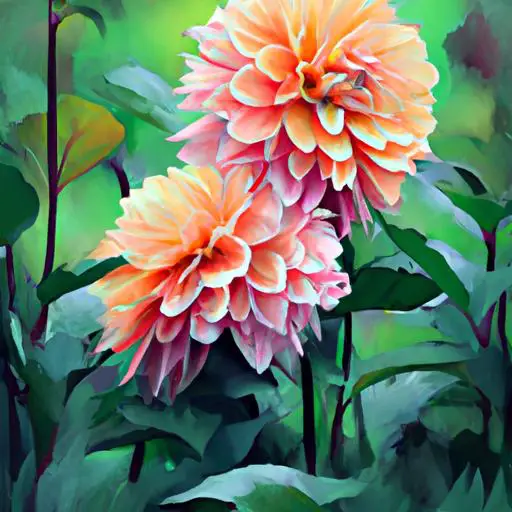Dinnerplate Dahlias are an eye-catching flower that can liven up any garden or bouquet.
With their bright colors, huge blooms, and warm colors, these flowers are the perfect addition to any flowerbed or centerpiece.
In this article, we’ll explore everything you need to know about dinnerplate dahlias, from their origin and characteristics to the different types, how to grow them, how to care for them, how to design with them, and even how to harvest them.
Read on to learn all the ins and outs of dinnerplate dahlias!
Table of Contents
Short Answer
Dinnerplate dahlia is a variety of dahlia flower that is characterized by its large size and flat shape.
The flowers usually have a diameter of 8 to 12 inches and usually come in a wide range of colors.
The flowers are also quite long-lasting, making them a popular choice for bouquets and other decorations.
They are also relatively easy to grow, as long as they are planted in a sunny, well-draining spot.
Origin and Characteristics of Dinnerplate Dahlias
Dinnerplate dahlias are a type of flower that originated in Central and South America.
They are members of the Asteraceae family, which also includes sunflowers and daisies.
These gorgeous flowers have been popular for many years and are well known for their large blooms and vibrant colors.
They are commonly used in gardens and landscaping projects, as they are quite versatile and can thrive in a variety of climates and soil types.
Dinnerplate dahlias have large, bold blooms that can reach up to 10 inches in diameter.
They come in a range of colors, from soft pastels to deep purples and reds.
The petals are often ruffled or incurved, and the center of the flower is usually filled with tubular florets.
The flowers are usually held on long, stiff stems that can reach up to 4 feet in height.
The foliage is usually dark green and can be quite bushy.
Dinnerplate dahlias are low-maintenance, making them a great choice for beginning gardeners.
They are easy to grow and require minimal care.
They should be planted in well-draining soil, and they do best in full sun.
They can tolerate some partial shade, but they will not bloom as profusely.
They require regular watering, though they should not be overwatered.
Fertilizing is also important to ensure optimal growth and blooming.
Different Types of Dinnerplate Dahlias

When it comes to dinnerplate dahlias, there is no shortage of variety.
These flowers come in a vast range of colors and sizes, allowing gardeners to choose the perfect bloom for their landscape or garden.
Some of the most popular varieties include the giant dinnerplate dahlia, which has huge blooms up to 10 inches in diameter, and the cactus dinnerplate dahlia, which has spiky petals that give the flower a unique texture.
Other common varieties include the decorative dinnerplate dahlia, which has flatter, smaller blooms, and the pompom dahlia, which has rounded petals that create a fluffy texture.
No matter which type of dinnerplate dahlia you choose, youll be sure to have a beautiful addition to your garden.
Growing Dinnerplate Dahlias in the Garden
When it comes to adding a touch of color and beauty to any garden, dinnerplate dahlias are the perfect choice.
These large, showy flowers have been favorites among gardeners for centuries and they are easy to care for.
Dinnerplate dahlias come in a variety of colors and sizes, ranging from small, 6-inch blooms to large, 10-inch blooms.
Their bright petals and long stems make them a great choice for garden borders or beds, and they are also excellent for cutting and arranging.
When growing dinnerplate dahlias, its important to choose the right spot in your garden.
They prefer full sun and well-drained soil, and you should aim for at least six hours of direct sunlight daily.
If youre planting in a container, make sure its large enough to accommodate the size of the flower, as the plants can reach up to three feet in height.
When planting, its important to prepare the soil properly.
Work in some compost or well-rotted manure to add nutrients and improve drainage.
You should also make sure to space your plants adequately – dahlias need room to grow and spread out.
Once planting is complete, cover the soil with a layer of mulch or mulch and compost mix to help retain moisture and keep weeds at bay.
Once your dahlias are established, water them regularly, making sure the soil around the roots doesnt dry out.
Fertilize with a balanced fertilizer every few weeks, and deadhead spent blooms to encourage more flowers to grow.
If your plants need staking, use a sturdy stake or support system to keep them upright.
With the right care, dinnerplate dahlias will reward you with a stunning array of colorful blooms that are sure to brighten up your garden.
Plant them in a sunny spot, water and fertilize regularly, and enjoy the show!
Caring for Dinnerplate Dahlias

When it comes to caring for dinnerplate dahlias, there are a few key points to keep in mind.
First, they require plenty of sunlight and should be planted in an area with at least six hours of direct sunlight per day.
They also need well-drained soil, so make sure to plant them in an area with good drainage.
Additionally, dahlias should be watered deeply and regularly, especially during the summer months when they are actively growing.
Its important to ensure that the soil does not become soggy, as this can cause the plants to rot.
Finally, dahlias should be fertilized every two to three weeks during the growing season with a high-quality fertilizer.
This will help keep the plants healthy and promote blooms.
Designing with Dinnerplate Dahlias
When it comes to designing with dinnerplate dahlias, the possibilities are endless.
These versatile flowers are a great choice for adding a splash of color to any garden or landscape.
Whether you are looking to create a show-stopping display of bright colors or a subtle mix of muted tones, dinnerplate dahlias can be used to create a stunning arrangement.
The blooms of dinnerplate dahlias come in a range of colors, from bright oranges and reds to subtle pinks and whites.
They are also available in various sizes, from small-sized blooms of up to six inches in diameter to large blooms of up to 10 inches in diameter.
This variety allows you to create unique combinations of colors and sizes to create a beautiful and eye-catching display.
When designing with dinnerplate dahlias, it is important to consider the environment in which they will be planted.
These flowers thrive in sunny and well-drained locations, so it is important to ensure that the soil is well-drained and that the area receives ample sunlight.
The plants can also be grown in containers, making them a great choice for those with limited garden space.
Additionally, they are a great choice for those looking to add a pop of color to a commercial landscape, such as a hotel or office building.
Finally, dinnerplate dahlias are relatively easy to care for.
They require regular watering and fertilizing, as well as occasional deadheading to encourage more blooms.
With the right care, these flowers can provide color and texture to a garden or landscape for months.
Common Pests and Diseases of Dinnerplate Dahlias

Dinnerplate dahlias are generally hardy and easy to care for, but they can be susceptible to certain pests and diseases.
The most common pests are aphids, thrips, and mites, which can cause discoloration and distortion of the plants leaves.
To combat these, gardeners can use horticultural oil, insecticidal soap, or neem oil.
Fungal diseases, such as powdery mildew, are also a common problem for dinnerplate dahlias.
To prevent these, it is important to water the plants at the base and avoid wetting the foliage.
Mulching around the plants can also help to reduce the risk of fungal diseases.
It is also important to keep an eye out for signs of root rot, which can be caused by overwatering or planting in poorly drained soil.
If left untreated, root rot can cause the plants to become stunted and produce fewer blooms.
To prevent root rot, make sure the plants are planted in well-draining soil and water only when the top few inches of soil are dry.
Finally, it is important to inspect the plants regularly for signs of pests or diseases and take action quickly if any are found.
With a little bit of care and attention, dinnerplate dahlias can be a beautiful addition to any garden.
Harvesting Dinnerplate Dahlias
Harvesting Dinnerplate Dahlias is an easy and fun task that can be done with very little effort.
The best time to harvest these showy flowers is when the blooms are fully open and the petals are at their fullest.
When harvesting, you should be sure to have a pair of scissors or pruners handy.
Cut the stems below the base of the flower, leaving a few inches of stem attached.
Make sure the stem is long enough to insert into a vase or container for displaying the flower indoors.
It is important to note that harvesting the flowers too early or too late can affect the blooms.
If the flowers are harvested too early, the blooms may not open as wide as they would if harvested at the peak of their beauty.
If the flowers are harvested too late, the blooms may not last as long and the petals may start to curl and wither.
When harvesting from the garden, you should also be aware of any pests or diseases that may be present.
If there are any signs of infection, it is best to avoid harvesting from that particular plant as it could spread to other plants.
Additionally, be sure to take note of any deadheading or pruning that needs to be done to keep the plant healthy.
Harvesting Dinnerplate Dahlias is a great way to bring these beautiful blooms indoors to enjoy.
With the right care and attention, these flowers will last for weeks and provide you with a stunning display of color.
So, get out there and start harvesting!
Final Thoughts
Dinnerplate dahlias are an excellent choice for gardeners looking to add a pop of color to their landscape.
Easy to care for and available in a variety of colors and sizes, dinnerplate dahlias can thrive in most climates and soil types.
With a little bit of knowledge and care, you can enjoy the beauty of these showy flowers in your own garden.
So why not give dinnerplate dahlias a try? With their impressive blooms, they are sure to make a stunning addition to any garden.

